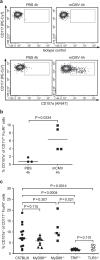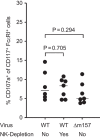Mast cells as rapid innate sensors of cytomegalovirus by TLR3/TRIF signaling-dependent and -independent mechanisms
- PMID: 25152077
- PMCID: PMC4654297
- DOI: 10.1038/cmi.2014.73
Mast cells as rapid innate sensors of cytomegalovirus by TLR3/TRIF signaling-dependent and -independent mechanisms
Abstract
The succinct metaphor, 'the immune system's loaded gun', has been used to describe the role of mast cells (MCs) due to their storage of a wide range of potent pro-inflammatory and antimicrobial mediators in secretory granules that can be released almost instantly on demand to fight invaders. Located at host-environment boundaries and equipped with an arsenal of pattern recognition receptors, MCs are destined to be rapid innate sensors of pathogens penetrating endothelial and epithelial surfaces. Although the importance of MCs in antimicrobial and antiparasitic defense has long been appreciated, their role in raising the alarm against viral infections has been noted only recently. Work on cytomegalovirus (CMV) infection in the murine model has revealed MCs as players in a novel cross-talk axis between innate and adaptive immune surveillance of CMV, in that infection of MCs, which is associated with MC degranulation and release of the chemokine CCL5, enhances the recruitment of protective CD8 T cells to extravascular sites of virus replication, specifically to lung interstitium and alveolar epithelium. Here, we have expanded on these studies by investigating the conditions for MC activation and the consequent degranulation in response to host infection. Surprisingly, the data revealed two temporally and mechanistically distinct waves of MC activation: an almost instant indirect activation that depended on TLR3/TRIF signaling and delayed activation by direct infection of MCs that did not involve TLR3/TRIF signaling. Cell type-specific Cre-recombination that yielded eGFP-expressing reporter virus selectively originating from MCs identified MC as a new in vivo, first-hit target cell of productive murine CMV infection.
Figures






Similar articles
-
Mast cells expedite control of pulmonary murine cytomegalovirus infection by enhancing the recruitment of protective CD8 T cells to the lungs.PLoS Pathog. 2014 Apr 24;10(4):e1004100. doi: 10.1371/journal.ppat.1004100. eCollection 2014 Apr. PLoS Pathog. 2014. PMID: 24763809 Free PMC article.
-
Human Cytomegalovirus Particles Treated with Specific Antibodies Induce Intrinsic and Adaptive but Not Innate Immune Responses.J Virol. 2017 Oct 27;91(22):e00678-17. doi: 10.1128/JVI.00678-17. Print 2017 Nov 15. J Virol. 2017. PMID: 28878085 Free PMC article.
-
Mast cells: innate attractors recruiting protective CD8 T cells to sites of cytomegalovirus infection.Med Microbiol Immunol. 2015 Jun;204(3):327-34. doi: 10.1007/s00430-015-0386-1. Epub 2015 Feb 4. Med Microbiol Immunol. 2015. PMID: 25648117 Review.
-
The TLR3/TICAM-1 pathway is mandatory for innate immune responses to poliovirus infection.J Immunol. 2011 Nov 15;187(10):5320-7. doi: 10.4049/jimmunol.1101503. Epub 2011 Oct 12. J Immunol. 2011. PMID: 21998457
-
Molecular characterization of HCMV-specific immune responses: Parallels between CD8(+) T cells, CD4(+) T cells, and NK cells.Eur J Immunol. 2015 Sep;45(9):2433-45. doi: 10.1002/eji.201545495. Epub 2015 Aug 24. Eur J Immunol. 2015. PMID: 26228786 Review.
Cited by
-
Exosomes From Packed Red Cells Induce Human Mast Cell Activation and the Production of Multiple Inflammatory Mediators.Front Immunol. 2021 May 6;12:677905. doi: 10.3389/fimmu.2021.677905. eCollection 2021. Front Immunol. 2021. PMID: 34025676 Free PMC article.
-
The Response of Tissue Mast Cells to TLR3 Ligand Poly(I:C) Treatment.J Immunol Res. 2020 Feb 24;2020:2140694. doi: 10.1155/2020/2140694. eCollection 2020. J Immunol Res. 2020. PMID: 32185237 Free PMC article.
-
Influenza A Viruses Replicate Productively in Mouse Mastocytoma Cells (P815) and Trigger Pro-inflammatory Cytokine and Chemokine Production through TLR3 Signaling Pathway.Front Microbiol. 2017 Jan 12;7:2130. doi: 10.3389/fmicb.2016.02130. eCollection 2016. Front Microbiol. 2017. PMID: 28127293 Free PMC article.
-
Cytomegalovirus: Shape-Shifting the Immune System.J Immunol. 2018 Jun 15;200(12):3881-3889. doi: 10.4049/jimmunol.1800171. J Immunol. 2018. PMID: 29866770 Free PMC article. Review.
-
Toll-like receptor-mediated innate immunity against herpesviridae infection: a current perspective on viral infection signaling pathways.Virol J. 2020 Dec 9;17(1):192. doi: 10.1186/s12985-020-01463-2. Virol J. 2020. PMID: 33298111 Free PMC article. Review.
References
-
- 2Collington SJ, Williams TJ, Weller CL. Mechanisms underlying the localisation of mast cells in tissues. Trends Immunol 2011; 32: 478–485. - PubMed
-
- 3Wernersson S, Pejler G. Mast cell secretory granules: armed for battle. Nat Rev Immunol 2014; 14: 478–494. - PubMed
-
- 4Rodewald HR, Feyerabend TB. Widespread immunological functions of mast cells: fact or fiction? Immunity 2012; 37: 13–24. - PubMed
Publication types
MeSH terms
Substances
LinkOut - more resources
Full Text Sources
Other Literature Sources
Medical
Molecular Biology Databases
Research Materials

